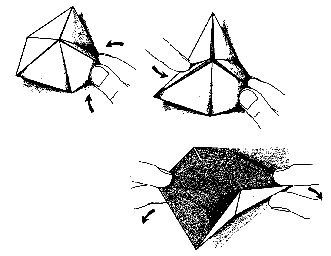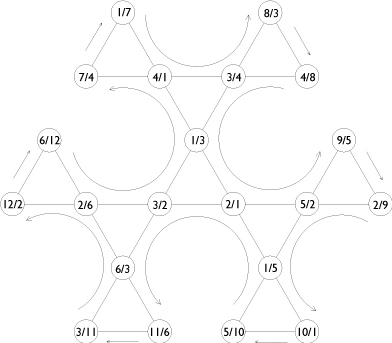Flexagons
A Bit About Flexagons
Ever since my junior high math teacher taught me how to make flexagons, I’ve thought they were cool. Recently, I’ve started to make flexagons with pictures on the faces. I’ve sent several hexahexaflexagons as birthday cards. I’ve been experimenting with using a dodecahexaflexagon as a rosary or prayer wheel analog. A meditative tool for focusing the mind.
Flexagons were discovered in 1939 by Arthur H. Stone, then a graduate student at Princeton University. He and his colleagues developed much of what is known about flexagons. Most of what I know about flexagons came from Martin Gardner’s “Mathematical Games” columns in Scientific American, which are available in book form. I have borrowed the figure below, demonstrating how to flex, from his article. (The other figures on these pages are my creations.)
There are many kinds of flexagons, with varying numbers of faces and edges, but I find the symmetric hexaflexagons the most interesting. They are characterized by three-fold symmetry at the “center” with two-fold symmetry in the “outer” layers. They can be made with 3 times any power of two faces, that is, 3, 6, 12, 24, etc.
Though the higher order flexagons are difficult to make, due to the mechanical limitations of paper, they are easy to simulate on a computer.
Making a Hexahexaflexagon
I have included instructions for making a hexahexaflexagon (6 faces) in a separate page. It is simple to generalize these to any higher order.
How to Flex a Hexaflexagon

Flex a flexagon by pinching together two adjacent triangles (top left). The inner edge of the two opposite triangles may be opened with the other hand (top right to bottom). If the flexagon opens, it can be turned inside out, revealing a face that was not visible before. If it cannot be opened, then pinch an adjacent pair of triangles instead.
Finding All the Faces Of a Hexaflexagon (the Tuckerman Traverse)
Flexing the same edge repeatedly, rotating only when necessary to flex, eventually cycles through all the faces. This is known as a Tuckerman traverse, after Bryant Tuckerman, who first discovered it.
The faces are numbered such that faces 1, 2, and 3 are the faces of a trihexaflexagon, and adding faces 4, 5, and 6 yields the additional faces of a hexahexaflexagon, etc. That way, the face numbers remain consistent for a trihexaflexagon, a hexahexaflexagon, a dodecahexaflexagon, or any higher order.
State diagrams for different orders of hexaflexagons can be easily generalized from the diagram.
The state diagram below shows a Tuckerman traverse on a dodecahexaflexagon. Each circle represents a unique configuration of the flexagon. The numbers within each circle represent the top and bottom faces in that configuration. The arrows indicate the direction of traverse. Rotating and flexing is represented in the diagram by exiting a configuration via the other exit.
There’s an easy rhythm I fall into while flexing, where I flex and then rotate the flexagon 60 degrees, and then flex again and rotate. This flips through a cycle of the same three faces, over and over. This can be an aid to meditation in much the same way that a rosary or a prayer wheel can be.
Not rotating the flexagon between flexes, or rotating an extra 60 degrees allows escape from the original cycle into another, which includes the face just flexed from, plus the face which would have been flexed into, with its triangles permuted, plus a new face not part of the original cycle. Sometimes there is only one way to flex a face, indicating that escape will have to wait for another face.
Finding All the Faces Of a Hexaflexagon (the Tuckerman Traverse)
Flexing the same edge repeatedly, rotating only when necessary to flex, eventually cycles through all the faces. This is known as a Tuckerman traverse, after Bryant Tuckerman, who first discovered it.
The faces are numbered such that faces 1, 2, and 3 are the faces of a trihexaflexagon, and adding faces 4, 5, and 6 yields the additional faces of a hexahexaflexagon, etc. That way, the face numbers remain consistent for a trihexaflexagon, a hexahexaflexagon, a dodecahexaflexagon, or any higher order.
State diagrams for different orders of hexaflexagons can be easily generalized from the diagram.
The state diagram below shows a Tuckerman traverse on a dodecahexaflexagon. Each circle represents a unique configuration of the flexagon. The numbers within each circle represent the top and bottom faces in that configuration. The arrows indicate the direction of traverse. Rotating and flexing is represented in the diagram by exiting a configuration via the other exit.

The various trianges in the diagram represent 3-cycles into which a flex-and-rotate combination can lead you. This flex-and-rotate pattern is very easy to do, as it is a natural movement to rotate the flexagon as you open it up from flexing.
Turning the flexagon over and flexing will run backwards through the diagram.
An Interactive Flexagon Flexer
I have an interactive flexer implementing using HTML5 and Canvas. This example flexes a dodecahexaflexagon (12 faces) with face diagrams as in my examples on each face, so that you can see the permutations.
Other Flexagon Pages
I should have included this several years ago, but I’ve been very lazy. I’ll try to add more, but at the moment, the most fun pages are Vi Hart’s flexagon videos. I think the easiest way to see them all is at her Khan Academy site.